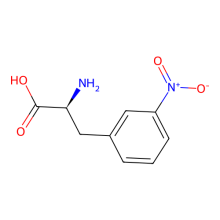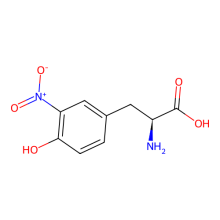RS/tRNA Foundational Publication Support
Porter, Joseph J, Hyo Sang Jang, Elise M Van Fossen, Duy P Nguyen, Taylor S Willi, Richard B Cooley, and Ryan A Mehl. (2019) 2019. “Genetically Encoded Protein Tyrosine Nitration In Mammalian Cells.”. Acs Chemical Biology 14 (6): 1328-1336. doi:10.1021/acschembio.9b00371.
RS/tRNA Pair Development Year
2019
ncAA(s) Incorporated
3-nitro-L-phenylalanine
ncAA Structure (png, jpg, jpeg)

ncAA Utility
can quench Trp fluoresence via FRET in a distance dependent manner. May also be useful as a control for use in studies of the roles of 3-nitroTyr in protein structure-function.
3-nitro-L-tyrosine
ncAA Structure (png, jpg, jpeg)

ncAA Utility
3-nitroTyr is a natural post-translational modification of proteins typically resulting from protein oxidation by peroxynitrite. It increases in many diseases and with age. Still unknown is if it can be reversed (by a denitrase) and if it has has a purposeful signaling role, or if it is only a modification associated with pathologies. It is known in some cases to contribute to disease pathology, but in most cases it is unknown how much it causes pathology vs. being a consequence of pathology. The ability to site specifically and quantitatively place 3-nitroTyr in positions in proteins that have been seen to occur in association with disease is a key tool to answer questions about its possible roles in normal physiology and disease.
RS Organism of Origin
Parent RS
RS Mutations
N311S
C313S
C313S
tRNA Organism of Origin
Parent tRNA
tRNA Anticodon
CUA
RS/tRNA Availability
n/a
RS/tRNA Additional Notes
In E coli, this RS was performed generated highly efficient full-fidelity (by Mass spec) incorporation into sfGFP(150) of 3NY at ~340 mg/L (~65% efficiency) and of 3-nitroPhe at ~750 mg/L (~150% efficiency) with UP50-values of ~90 and ~600 microM respectively. In HEK293T cells showed no incorporation of 3NY (at 0.3 mM) but incorporated 3-nitroPhe (at 1 mM) at ~25% efficiency into sfGFP(150). Because the RS did not incorporate 3NY in the mammalian cells it was not further characterized, even though it appears to perform very well as a 3-nitroPhe RS. Also, at 1 mM, the 3-nitroPhe showed no toxicity in the HEK cells.
